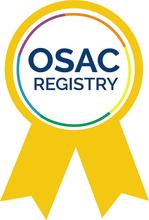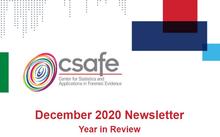January 2021
This Standards Bulletin from the Organization of Scientific Area Committees (OSAC) for Forensic Science provides an update on:
- Standards moving through the OSAC Registry approval process.
- Standards moving through the development process at standards developing organizations (SDOs).
Standards under consideration for the OSAC Registry and open for comment: 8
Documents recently published by an SDO: 1
SDO documents open for comment: 13
In this issue
OSAC Registry Updates

The OSAC Registry is a repository of high-quality, technically sound published and proposed standards for forensic science. These written documents define minimum requirements, best practices, standard protocols and other guidance to help ensure that the results of forensic analysis are reliable and reproducible.
Standards Under Consideration for the OSAC Registry
SDO Published Standards Open for Comment
The following SDO published standards are being considered for the OSAC Registry. Please submit your comments by 11:59 p.m. ET on February 5, 2021 on whether they should be included on the Registry:
Biology/DNA
- ANSI/ASB Standard 023, Standard for Training in Forensic DNA Isolation and Purification Methods, First Edition, 2020. Submit your comments here.
- ANSI/ASB Standard 110, Standards for Training in Forensic Serological Methods, First Edition, 2020. Submit your comments here.
- ANSI/ASB Standard 115, Standard for Training in Forensic Short Tandem Repeat Typing Methods using Amplification, DNA Separation, and Allele Detection, First Edition, 2020. Submit your comments here.
- ANSI/ASB Standard 116, Standard for Training in Forensic DNA Quantification Methods, First Edition, 2020. Submit your comments here.
Fire Debris
- ASTM E3197-20 Standard Terminology Relating to Examination of Fire Debris. Submit your comments here.
- ASTM E3245-20 Standard Guide for Systematic Approach to the Extraction, Analysis, and Classification of Ignitable Liquids and Ignitable Liquid Residues in Fire Debris Samples. Submit your comments here.
Firearms & Toolmarks
- ANSI/ASB Standard 068, Best Practice Recommendation for the Safe Handling of Firearms and Ammunition, First Edition, 2020. Submit your comments here.
Gunshot Residue
- ASTM E1588-20 Standard Practice for Gunshot Residue Analysis by Scanning Electron Microscopy/Energy Dispersive X-Ray Spectrometry. Submit your comments here.
Criminal justice agencies can access the ASTM standards listed above by visiting OSAC’s Access to Standards webpage.
For a list of all standards currently under Registry consideration, please visit the OSAC website.
Has your organization already started implementing OSAC Registry approved standards?
Complete OSAC’s Laboratory Implementation Declaration Form and send it
to mark.stolorow [at] nist.gov (mark[dot]stolorow[at]nist[dot]gov) to let us know. OSAC will award your organization with an OSAC Standards Implementer Certificate.
Share your implementation experience and be featured in a future OSAC news post.
SDO Updates
Documents Recently Published by an SDO
The following document has been recently reaffirmed by the American Dental Association (ADA):
- ANSI/ADA Standard 1058-2010 (R2020), Forensic Dental Data Set. This document, initially drafted by OSAC’s Odontology Subcommittee, provides uniform nomenclature for the description of forensic dental data and defines a standardized set of uniform terms to convey this information (reaffirmation of ANSI/ADA Standard 1058-2010 (R2015).
SDO Documents Open for Comment
AAFS Standards Board (ASB):
- Recirculation* – ASB Standard 061, Firearms and Toolmarks 3D Measurement Systems and Measurement Quality Control, First Edition. This document provides requirements for the measurement systems (the instruments and included scan acquisition software) which capture data beyond a flat 2D photographic image for Firearm and Toolmark Analysis (these systems are referred to as 3D systems in this document). This standard provides requirements to ensure the instrument’s accuracy, to conduct instrument calibration, and to estimate measurement uncertainty for each axis (X, Y, and Z). Included in the standard are procedures for validation of 3D system hardware. The focus of this standard is on the hardware and resulting measurement data and does not include the requirements for measurement systems software. Comment deadline January 14, 2021.
- Recirculation* – ASB Standard 098, Standard for Mass Spectral Data Acceptance in Forensic Toxicology, First Edition. This document provides criteria for the acceptance of mass spectral analyses of small molecules (compounds with an atomic weight of less than 800 daltons) in laboratories conducting any of the following forensic toxicology subdisciplines: postmortem forensic toxicology, human performance toxicology (e.g., drug-facilitated crimes and driving-under-the-influence of alcohol or drugs), non-regulated employment drug testing, court-ordered toxicology (e.g., probation and parole, drug courts, child services), and general forensic toxicology (non-lethal poisonings or intoxications). The document provides minimum requirements for acquiring data on single- or multiple-stage mass spectrometers using low- or high-resolution mass spectrometers. It also provides instruction on the evaluation of mass spectral data when conducting acquisitions in full-scan mode, selected ion monitoring, multiple-stage analyses, or when using high-resolution mass analyzers. Criteria, requirements, and instructions in this document are not intended for the area of breath alcohol toxicology. Further, it is not intended to address the use of matrix-assisted laser desorption, inductively coupled plasma, or ion mobility mass spectrometry. It is also not intended to provide criteria for analyte identification in forensic toxicology laboratories. Comment deadline January 18, 2021.
- Recirculation* – ASB Standard 113, Standard for Identification Criteria in Forensic Toxicology, First Edition. This document sets minimum criteria, based on a point system, for the identification of an analyte during forensic toxicology testing. The document provides a mechanism for laboratories to evaluate each analytical technique to determine if their testing regimen is sufficient to meet or exceed the minimum points required for identification. This document does not address identification of alcohols, carbon monoxide, cyanide, or metals. Comment deadline January 18, 2021.
- ASB Standard 139, Reporting DNA Conclusions, First Edition. This standard contains the reporting requirements for autosomal STR and haplotype DNA conclusions for results obtained from evidentiary samples in forensic casework and does not apply to paternity or any other biological relatedness conclusions. This standard only addresses the requirements for providing DNA conclusions in the report. Comment deadline January 18, 2021.
- Recirculation* – ASB Best Practice Recommendation 060, Guidelines for Barrel and Overall Length Measurements of Firearms, First Edition. This document provides guidelines for measuring and reporting barrel length and overall length (BL-OL) of firearms, including guidelines for measurement traceability and estimating uncertainty of BL-OL measurements. This document does not apply to descriptive measurements of firearms. Comment deadline January 25, 2021.
- ASB Best Practice Recommendation 107, Best Practice Recommendation for Measuring Trigger Pull of a Firearm and Estimating Its Uncertainty, First Edition. This document provides procedures for trigger pull measurements and for estimating uncertainties associated with trigger pull measurements. Comment deadline January 25, 2021.
- ASB Best Practice Recommendation 142, Best Practice Recommendations for the Resolution of Conflicts in Friction Ridge Examination, First Edition. This document provides the best practice recommendations for how to resolve conflicts between examiners at any point during the technical review or verification process of conflicting suitability decisions, conflicting source conclusions, and documentation of conflict resolution. This document does not address differences of opinion that occur at the consultation level or any organizational response once an error is discovered or the conflict(s) is(are) resolved. Comment deadline January 25, 2021.
- ASB Best Practice Recommendation 143, Best Practice Recommendations for Technical Review in Friction Ridge Examination, First Edition. This document provides best practice recommendations for how to perform technical reviews of friction ridge impression examinations. The document provides general guidance on technical reviews best practices including a check list and sample review forms. This document does not address administrative review, verification, or testimony monitoring. Comment deadline January 25, 2021.
- ASB Best Practice Recommendation 144, Best Practice Recommendations for the Verification Component in Friction Ridge Examination, First Edition. This document provides best practice recommendations for how to conduct the verification phase during friction ridge impression examinations. These recommendations apply to both suitability determinations and resulting conclusions addressing verification considerations (e.g., extent, utility, case type, approach), types of verification and application options, and documentation. This document does not address technical review. Comment deadline January 25, 2021.
- Recirculation* – ASB Standard 119, Standard for the Analytical Scope and Sensitivity of Forensic Toxicological Testing of Blood in Medicolegal Death Investigations, First Edition. This document delineates the minimum requirements for target analytes and analytical sensitivity for the forensic toxicological testing of blood specimens collected in medicolegal death investigations. This document does not cover the analysis of urine, tissues, or other specimens that are commonly analyzed in medicolegal death investigations. Comment deadline February 1, 2021.
- Recirculation* – ASB Standard 121, Standard for the Analytical Scope and Sensitivity of Forensic Toxicological Testing of Urine in Drug-Facilitated Crime Investigations, First Edition. This document delineates the minimum requirements for target analytes and analytical sensitivity for the forensic toxicological testing of urine specimens collected from alleged victims of drug-facilitated crimes (DFC). This document does not cover the analysis of blood and other evidence that may be collected in DFC cases. Comment deadline February 1, 2021.
- ASB Standard 149, Standard for Taphonomic Observations in Support of the Postmortem Interval, First Edition. This standard provides requirements for describing and analyzing the taphonomic effects on human remains and associated evidence that can be observed in the laboratory as well as in the field. Also, it provides requirements for recording and reporting the taphonomic and contextual indicators that contribute to estimating the postmortem interval in sufficient detail to allow for independent interpretation, replication, and verification of conclusions drawn. Comment deadline February 1, 2021.
- ASB Standard 158, Standard for a Developing Standard Operating Procedures in Bloodstain Pattern Analysis, First Edition. This standard provides guidance on the development of Standard Operating Procedures (SOP) that are a component of the quality assurance program for Bloodstain Pattern Analysis. The standard specifies SOP requirements for equipment, materials, reagents, calculations, documenting limitations, safety, and the generation of reports. The standard is applicable to scene, laboratory, and remote examinations. Comment deadline February 1, 2021.
*Comments on a recirculation will only be accepted on revised sections of a document; comments made to text not revised from the original comment period will not be accepted.
For the ASB documents listed above, download ASB's comment template and return it to asb [at] aafs.org (asb[at]aafs[dot]org) by the comment deadline.
Work Proposals for New or Revised Standards
The following documents are being initiated and are expected to results in a new or revised standard.
ASB:
- On December 4, 2020 a Project Initiation Notification System (PINS) was published on page 2 in the ANSI Standards Action. This will begin a 30-day period for public comment on the initiation of ASB’s work on the following document:
- BSR/ASB Std 154-202x, Standard for Training on Testimony for Forensic Biology. This document provides minimum training program requirements for forensic biology practitioners on scientific and legal principles necessary to testify.
Other News
Webinar: Biology/DNA Standards and Best Practices Developed by OSAC and ASB - Part 4

Join OSAC, ASB and Promega on Wednesday, January 20, 2021 at 12 p.m. EST for a webinar about ANSI/ASB Standard 018, Standard for Validation of Probabilistic Genotyping Systems, First Edition 2020.
In this webinar, learn:
- How this document was conceived, written, and developed into a published standard
- The key points covered by the standard
- How to implement the standard in a forensic science laboratory
This is the fourth webinar in the series providing information on new/emerging standards and best practice recommendations for forensic biology and DNA testing laboratories. Click the links below to view the three other webinars in this series:
- DNA Standards and Best Practices Developed by OSAC and ASB. Part 1: The Process.
- DNA Standards and Best Practices Developed by OSAC and ASB. Part 2: Mixture Interpretation Validation, and Protocol Development and Verification.
- DNA Standards and Best Practices Developed by OSAC and ASB. Part 3: Training Standards Overview.
CSAFE's December 2020 Newsletter

Our colleagues at The Center for Statistics and Applications in Forensic Evidence (CSAFE) published their December 2020 Newsletter. Check it out to access the two CSAFE Center Wide Webinars, Crime Lab Proficiency Testing and Quality Management and Mock Juror Perceptions of Forensics, as well as to look back at the other CSAFE highlights from 2020.
Get Involved with OSAC
OSAC offers a variety of ways for members, affiliates and other experts in the forensic science community to participate in the standards advancement process. Click here to learn how you can help make an impact on the forensic science community through standards.

